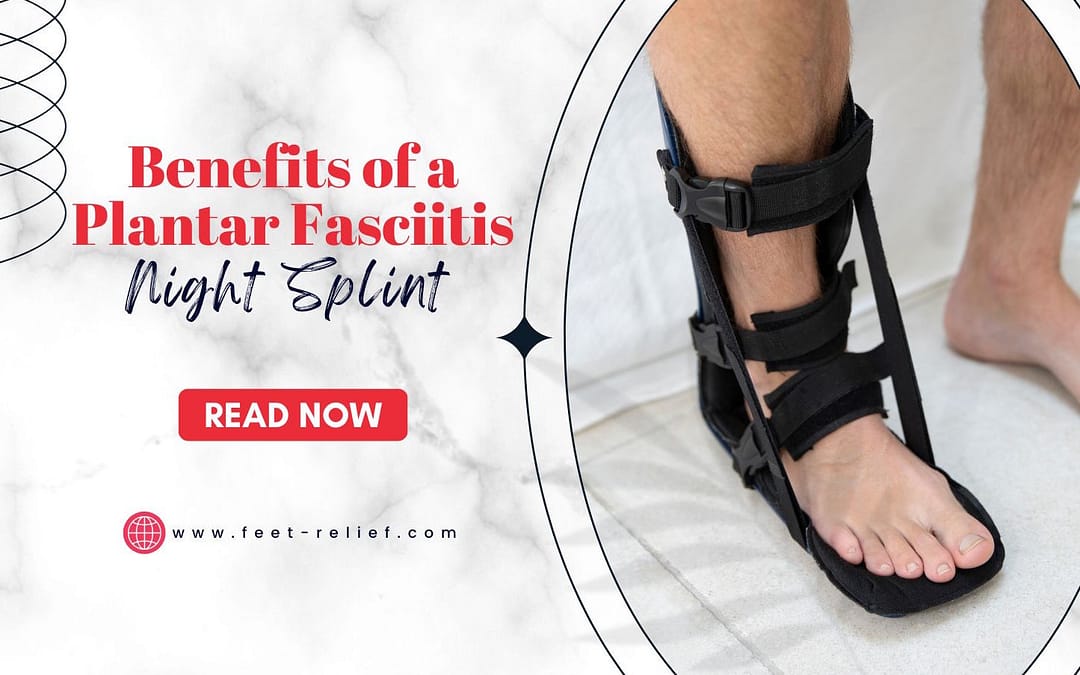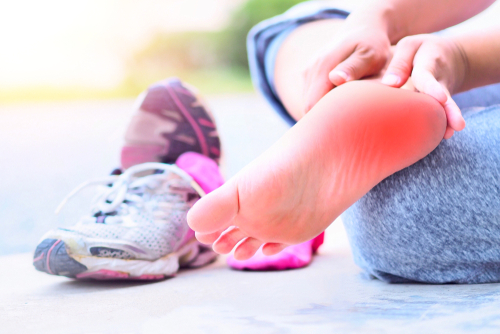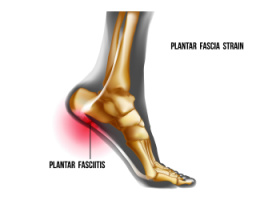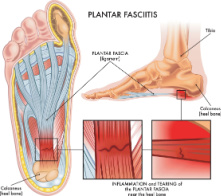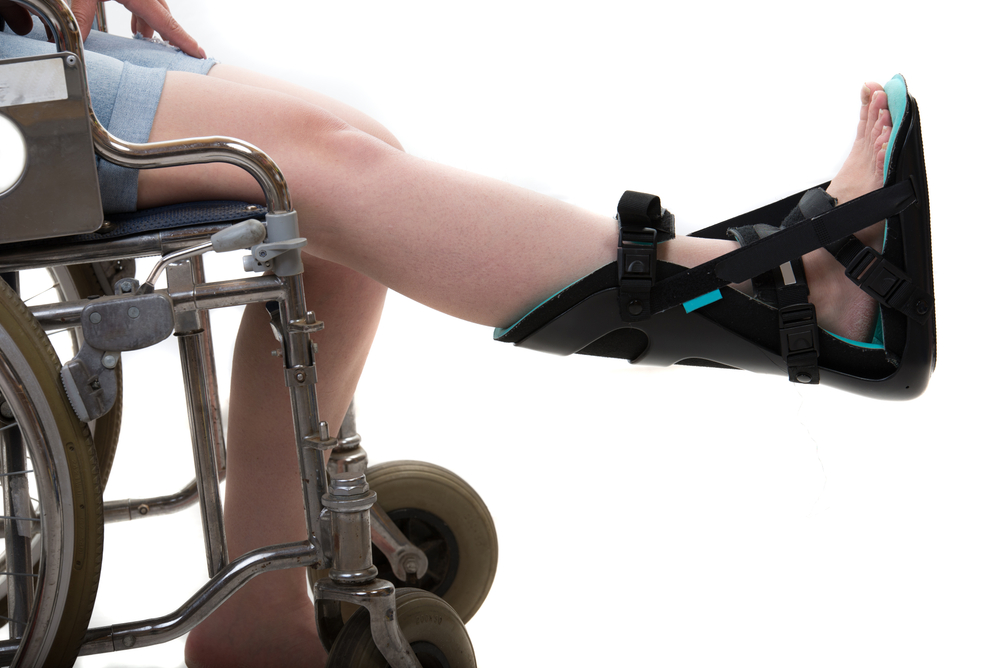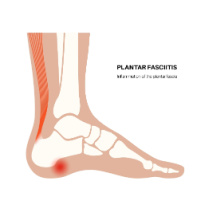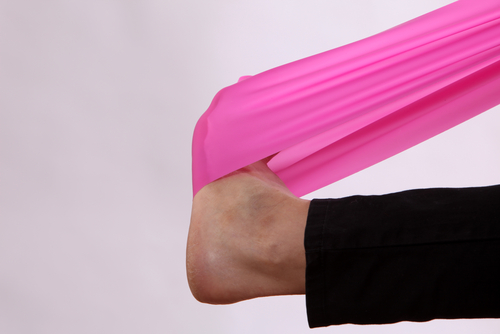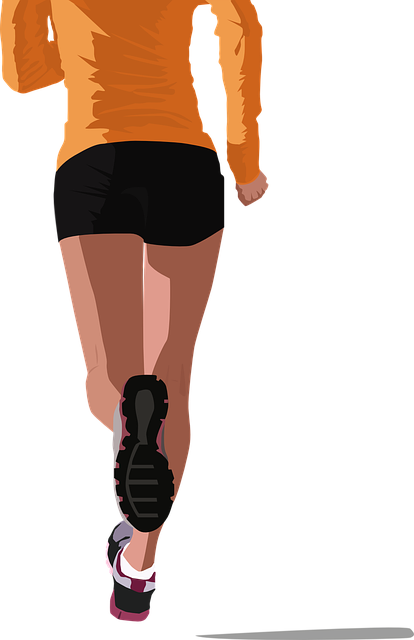Feet-Relief is supported by our audience. When you purchase through one of our links, we may earn a small affiliate commission. As an Amazon Associate I earn from qualifying purchases.Your cost is not affected.
Relieve Foot Pain Instantly—The Benefits of a Plantar Fasciitis Night Splint
Imagine waking up every day without experiencing that agonizing stabbing pain in your heel. Such pain often seems to ruin your mornings. Using a plantar fasciitis night splint can immediately relieve your foot pain and become more comfortable. In this blog post, we’ll explore the benefits of plantar fasciitis night splints, the different types available, and how to choose the best one for your needs.
Key Takeaways
- Night splints can be used to help alleviate the symptoms of plantar fasciitis.
- When selecting a night splint, factors such as comfort, adjustability, and severity should be considered.
- Real-life success stories demonstrate how night splints provide pain relief from plantar fasciitis and improve quality of life.
Using Plantar Fasciitis Night Splints: Do they help?
Plantar fasciitis is a common condition caused by plantar fascia inflammation, a thick band of tissue connecting the heel bone to the toes. This inflammation can lead to sharp heel pain, stiffness, and difficulty walking, particularly in the morning. Experiencing morning foot pain can be a sign of plantar fasciitis. In some cases, it may be accompanied by other conditions such as Achilles tendonitis.
Research indicates that plantar fasciitis night splints can substantially improve symptoms. We’ll examine the causes, symptoms, and how night splints can aid in the treatment of this condition.
Causes of Plantar Fasciitis
The development of plantar fasciitis is attributed to:
- Inflammation and strain of the plantar fascia
- Wearing improper shoes
- Lower leg overuse injuries
- Foot arch irregularities
- Plantar flexion contractures.
Extended running and overutilization of the foot can also place excessive strain on the plantar fascia, resulting in inflammation and the condition. Providing support and stretch to the plantar fascia during sleep, a traditional night splint can help mitigate symptoms.
Symptoms of Plantar Fasciitis
Individuals suffering from plantar fasciitis and heel spurs commonly experience plantar fasciitis pain in the form of a stabbing sensation in the bottom of the foot near the heel, as well as stiffness and difficulty walking. This foot ankle issue can be quite debilitating for those affected.
Night splints assist in easing these symptoms by offering support and stretching to the plantar fascia.
Role of Night Splints in Treatment
Night splints are instrumental in plantar fasciitis treatment, as they:
- Keep the foot in a flexed position
- Facilitate a gentle stretching of the plantar fascia ligament
- Provide consistent stretch to the plantar fascia and Achilles tendon
- Alleviate discomfort, swelling, and inflammation
Devices like the Plantar Fasciitis Night Splint keep the foot in a neutral position, providing these benefits for plantar fasciitis treatment.
Night splints are an effective way to reduce pain and inflammation associated with plantar fasciitis, and many people wonder how night splints work to provide relief.
Types of Night Splints for Plantar Fasciitis Relief
There are two primary types of night splints used for plantar fasciitis relief: rigid and soft sock night splints. Rigid night splints offer a more intensive stretch and are suitable for severe or chronic plantar fasciitis cases, while soft sock night splints provide a gentle stretch, making them ideal for mild to moderate cases.
We’ll examine each type more thoroughly.
Rigid Night Splints
Rigid night splints are designed to offer a more aggressive stretch, making them suitable for severe or chronic plantar fasciitis cases. Employing a rigid night splint for plantar fasciitis has multiple advantages, such as:
- Enhancing circulation and blood flow
- Accelerating the healing process
- Preventing overnight muscle contraction
- Providing alleviation of foot pain
Individuals with severe or chronic cases of plantar fasciitis are recommended to use rigid night splints.
Soft Sock Night Splints
Soft sock night splints combine the comfort of a sock with the stretch of a night splint, making them suitable for mild to moderate cases of plantar fasciitis. They provide several benefits, including:
- Lightweight
- Softness
- Lack of straps
- Gentle stretch
- Ability to hold the foot in a stretched position
- Comfort
- Coolness while sleeping, making them more tolerable to wear regularly during the night.
These features make soft sock night splints an ideal choice for those suffering from plantar fasciitis.
How to Choose the Right Night Splint for Your Needs
Choosing an appropriate night splint is pivotal for achieving effective pain relief and managing plantar fasciitis. Consider factors such as comfort, adjustability, and the severity of your condition when choosing the most suitable night splint.
We’ll examine these aspects and incorporate expert recommendations to aid in your decision-making process.
Factors to Consider
When choosing a night splint, consider factors like comfort, adjustability, and the severity of your plantar fasciitis. The material of the splint helps determine comfort. Consider the breathability of the fabric and the size of the splint.
Adjustability can be determined by the type of straps or buckles used to secure the splint. Your doctor or physical therapist determines the severity of your plantar fasciitis.
Expert Recommendations
Experts can provide insight into the most suitable night splint for your particular circumstances, as well as instructions on how to use and maintain it. They can guide you in selecting the right type of splint based on your condition’s severity and advise on additional treatment options, such as stretching exercises, orthotic inserts, and supportive footwear.
These experts can help you make an informed decision about the best night splint for your needs.
Proper Usage and Care of Your Plantar Fasciitis Night Splint
Proper usage and care of your plantar fasciitis night splint is necessary to ensure optimal results and extend its lifespan.
This section will offer tips on how to use and maintain night splints for maximum effectiveness and durability.
Wearing Instructions
Follow the wearing instructions provided by the manufacturer to ensure correct usage and maximum benefits.
To do the night splint, follow these steps:
- Slide your foot into the brace.
- Adjust the straps to ensure a secure and comfortable fit.
- Position the splint correctly with the foot in a neutral position.
- Fasten the straps to keep the foot in place.
- Utilize the straps to modify the tension to your desired comfort level.
Wear the night splint overnight while sleeping to provide continuous support and stretch to the plantar fascia.
Cleaning and Maintenance
Regular cleaning and maintenance of your night splint will prolong its lifespan and maintain its effectiveness. Clean the splint with a damp cloth and mild soap, allowing it to air dry completely before storing.
Inspect the straps and buckles for signs of wear and tear, and replace the splint if it is damaged or worn out.
Additional Treatment Options for Plantar Fasciitis
Beyond using a night splint, integrating other treatment options into your daily routine can enhance pain relief and promote the healing of plantar fasciitis.
This section will delve into supplementary treatment options, including stretching exercises and orthotic inserts, that can complement your use of a night splint.
Stretching Exercises
Incorporating stretching exercises into your daily routine can help to reduce pain and inflammation, improve flexibility, and promote healing. Calf stretches, toe stretches, and arch stretches are recommended for treating plantar fasciitis.
For optimal results, stretching exercises should be done slowly and gently, with each stretch being held for a minimum of 30 seconds.
Orthotic Inserts and Supportive Footwear
Orthotic inserts and supportive footwear can provide additional relief and support for individuals suffering from plantar fasciitis. Orthotic inserts offer extra arch support and cushioning for the feet, reducing the strain on the plantar fascia.
Wearing supportive footwear with additional arch support and cushioning can also help alleviate the discomfort of plantar fasciitis.
Real-Life Success Stories: How Night Splints Changed Lives
Learn about the transformative impact of night splints on the lives of individuals suffering from plantar fasciitis. These real-life success stories demonstrate the power of night splints in providing significant pain relief and improving overall quality of life.
Julia Buccheim was able to effectively address her longstanding plantar fasciitis through a minimally invasive procedure, while Wendy Vanwinkle experienced relief from plantar fasciitis with the assistance of a night splint from BaronActive. These stories illustrate the life-changing impact that night splints can have on individuals suffering from this painful condition.
Will a fasciitis night splint help your foot pain?
Plantar fasciitis night splints offer a practical and effective solution for those seeking instant relief from foot pain. By understanding the causes and symptoms of plantar fasciitis, choosing the right night splint based on comfort, adjustability, and severity of your condition, and incorporating additional treatment options such as stretching exercises and orthotic inserts, you can take control of your plantar fasciitis pain and experience a significant improvement in your quality of life. Take the first step towards pain-free mornings by trying a plantar fasciitis night splint today.
Frequently Asked Questions
Do night splints work for plantar fasciitis?
Night splints are one of the most effective and conservative treatments for plantar fasciitis, and often help the fascia to heal when used alongside other treatments.
How long should you wear a night splint for plantar fasciitis?
Night splints should be worn for up to several months and can be adjusted to the desired angle. The largest medical research study found that 97.8% of patients recovered within 8 weeks and an average wearing period of 18.5 days.
What is the best thing to wear at night for plantar fasciitis?
For the best relief of plantar fasciitis at night, wearing a night splint is highly recommended. It stretches the foot arches and calves during sleep, preventing the plantar fascia from becoming overly relaxed and leading to early morning pain. Night splints are designed to be comfortable and adjustable, so you can find the perfect fit for your feet. They are also lightweight and easy to use, making them a great option for those who suffer from plantar fasciitis.
Why does my plantar fasciitis flare up at night?
Plantar fasciitis can flare up due to sudden increases in activity levels, wearing shoes without support, weight gain, or even not stretching regularly. The toes point in sleep at night, causing the plantar fascia to shorten, leading to increased inflammation and heel pain.
Amazon and the Amazon logo are trademarks of Amazon.com, Inc, or its affiliates.

